Trees Birds Mammals Fish Amphibians Reptiles
Wild Algarve
Bookshop
Daldinia concentrica (Bolton) Ces. & De Not. - King Alfred's Cakes
Phylum: Ascomycota - Class: Sordariomycetes - Order: Xylariales - Family: Xylariaceae
Distribution - Taxonomic History - Etymology - Identification - Reference Sources
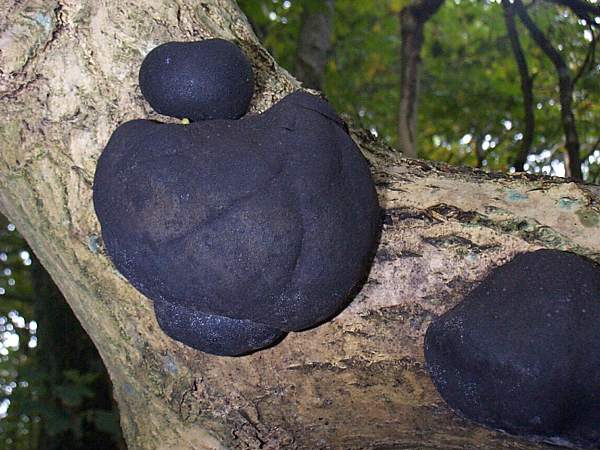
Common referred to as King Alfred's Cakes (a reference to their burnt appearance, of course, because having been given shelter by a peasant woman Alfred, preoccupied by other concerns, was reputed to have inadvertently allowed her cakes to burn, having promised that he would watch her cakes cooking. They are also referred to as Cramp Balls (because carrying them was thought to cure attacks of cramps). These hard, inedible
fungi appear most often on ash and beech wood but occasionally on other hardwood trees.
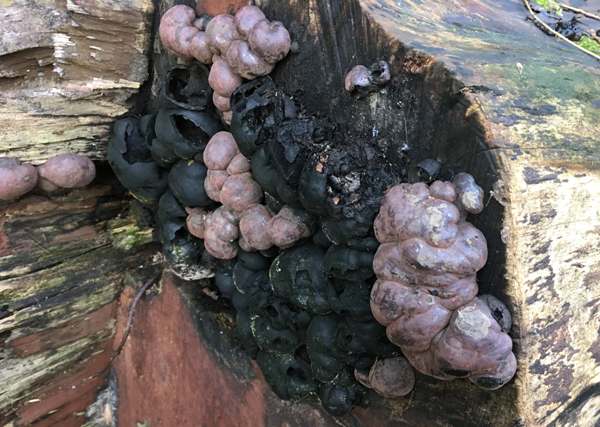
The pinkish-brown specimens shown above are young and still growing, and during this asexual stage they develop over a long period and release pallid, almost colourless spores known as conidiospores (or simply as conidia), which are pinkish white when seen in mass. Once fully grown the fruitbodies turn black, like those in the picture above. At this mature stage the surface becomes dotted with tiny bumps that are the openings of perithecia, the spore-producing structures located just below the surface. Ascospores, which unlike the pallid conidiospores are jet black, are ejected from these openings in vast numbers, soon covering the surface of the fruitbody and darkening the substrate wood (creating in effect a natural spore print)
for some distance around it.
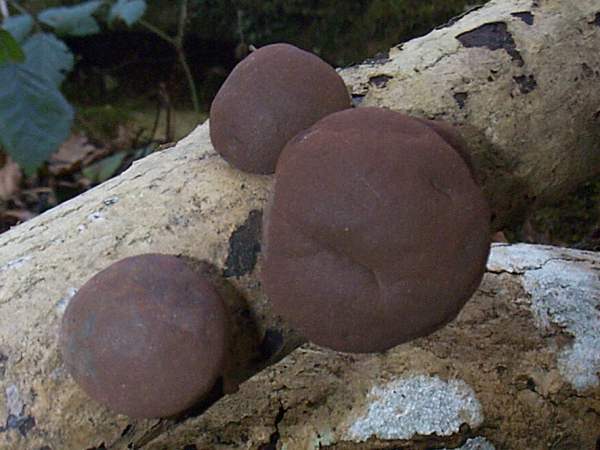
The perithecia are 0.5 to 0.8mm in diameter, and their tiny openings of the surface are visible only with quite strong magnification (see below).
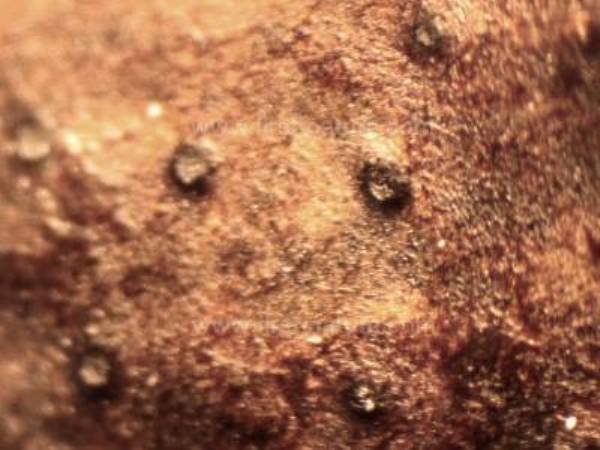
The necks of the perithecia are visible in the picture above; their separation is very variable. Beneath each of these tiny surface bumps these is an asci-lined flask where ascospores develop.
Distribution
Common and widespread in Britain and Ireland and found throughout most of mainland Europe, this saprobic fungus occurs also in North America, Australia and in many other temperate countries.
Taxonomic history
Described in 1791 by British mycologist James Bolton (c. 1735 - 1799), who gave it the scientific name Sphaeria concentrica, this ascomycetous fungus was transferred to the genus Daldinia in 1863 by Italian mycologists Vincenzo de Cesati (1806 - 1883) and Giuseppe De Notaris (1805 - 1877). Daldinia concentrica is the type species of its genus.
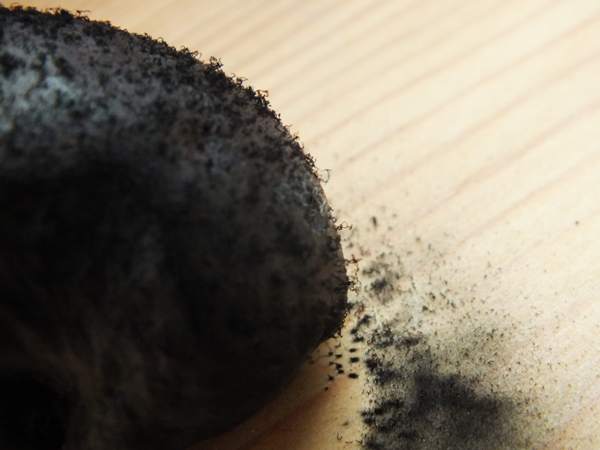
Daldinia concentrica has several synonyms including Fungus fraxineus Ray, Sphaeria fraxinea With., Sphaeria concentrica Bolton, Hypoxylon concentricum (Bolton) Grev., and Stromatosphaeria concentrica (Bolton) Grev.
Etymology
Inside the fruitbody
there are concentric silver-grey and black layers (pictured below), from which comes the the specific epithet concentrica.
Above: When you make a spore print of an agaricoid mushroom or of a bolete, the spores are deposited directly beneath the fertile surface - the gills or the pores. With flask fungi such as Daldinia concentrica the spores are ejected from asci buried within the stroma (fruitbody) and create a spore print extending outwards from the edge of the stroma. In this instance the spores have left a clearly visible black stain up to 3cm wide.
Identification guide
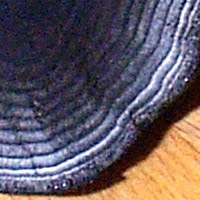 |
Fruitbody
Individual fruitbodies (formally referred to as stroma) of Daldinia concentrica are typically 2 to 8cm across, growing over several seasons (hence the growth rings), but several may merge to form a much larger compound
outgrowth. Initially brown and dense, the fruitbodies
soon turn black, dry out and become less
dense. There is no stipe; the fruitbody is attached to the host wood by a
broad, flat area underneath the cushion-shaped fruitbody. The spore-bearing surface is a series of tiny chambers called perithecia, which are embedded within the outside of the fruitbody, and
ejected spores leave a slightly darker area of wood around the fungus. Each season a new fertile outer layer develops with new perithecia, inside which the next season's ascospores are produced. Large stroma are therefore much older than small ones. |
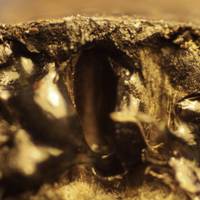 |
Perithecia
The picture on the left is a greatly magnified view of a perithecium, the dark chamber within which the asci form and spores are produced. As with other ascomycete fungi there are infertile paraphyses separating the asci.
Once the spores inside an ascus have reached maturity, the ascus expands lengthways,guided by the surrounding paraphyses, until its tip extends outside the neck of the perithecium; then water pressure built up inside the ascus bursts open the tip of the ascus and the ascospores are forcibly ejected. The ascus shrivels leaving the opening clear for the next set of eight spores to be expelled. |
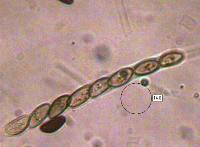 |
Asci
Each ascus contains eight ascospores. Asci are typically 200µm x 10-11µm, cylindrical, and the asci tips are amyloid.
|
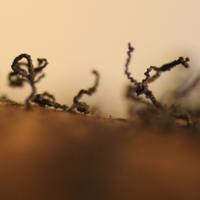 |
Ascospores are ejected, mainly it seems at night, from asci hidden within perithecia just below the black surface of the fruitbody. In creating overnight spore prints I have found that some spore dust is clearly visible as far as 3cm or more from the edge of the stroma (plural stromata); however, in windless conditions a high proportion of the spores stick to one another and emerge from the necks of the perithecia in the form of contorted ropes, as seen on the left. The ropes wave about and appear to be 'growing' as more spores are added to extend them at their attachment points.
|
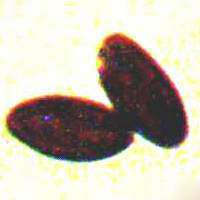 |
Spores
Ellipsoidal to fusiform, 12-17 x 6-9µm.
Spore print
Black |
Odour/taste |
Not distinctive. |
Habitat & Ecological role |
Saprobic, on dead or dying hardwood, nearly always of ash trees. A very
similar species occurs on beech. |
Season |
Ascospores are produced from late spring
through to the end of autumn, but fruitbodies (stroma) can be seen at any time of year. |
Similar species |
Several blackish crust-like fungi occur on dead wood. Kretzschmaria deusta is one example; it does not have concentric rings within
its fruitbody and does not form cushion-shaped or ball shaped
growths. |
Reference Sources
Fascinated by Fungi, 2nd Edition, Pat O'Reilly 2016, reprinted by Coch-y-bonddu Books in 2022.
Dennis, R.W.G. (1981). British Ascomycetes; Lubrecht & Cramer; ISBN: 3768205525.
Breitenbach, J. & Kränzlin, F. (1984). Fungi of Switzerland. Volume 1: Ascomycetes. Verlag Mykologia: Luzern, Switzerland.
Medardi, G. (2006). Ascomiceti d'Italia. Centro Studi Micologici: Trento.
Dictionary of the Fungi; Paul M. Kirk, Paul F. Cannon, David W. Minter and J. A. Stalpers; CABI, 2008
Taxonomic history and synonym information on these pages is drawn from many sources but in particular from the British Mycological Society's GB Checklist of Fungi.
Acknowledgements
This page includes pictures kindly contributed by Gill Broadfoot.
Top of page...
Fascinated by Fungi. Back by popular demand, Pat O'Reilly's best-selling 450-page hardback book is available now. The latest second edition was republished with a sparkling new cover design in September 2022 by Coch-y-Bonddu Books. Full details and copies are available from the publisher's online bookshop...